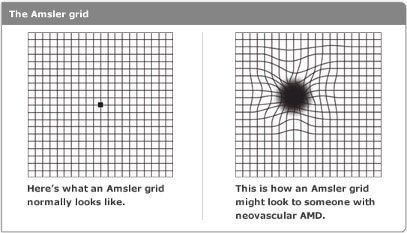Wet vs Dry Macular Degeneration

The difference between wet and dry age-related macular degeneration (AMD) is determined by the cause of the macular distortion. With wet AMD, the function of the macula is impeded by the growth and leakage of abnormal blood vessels beneath the retina. Dry AMD is the result of aging and the thinning of the macula over time. These divergent causes result in different treatments and prognoses for the two types of retinal disorder.
What is Macular Degeneration?
Macular degeneration is a disorder of the retina. The macula is a small, central portion of the retina responsible for straight ahead vision. This is the part of your vision that enables reading, driving, and the ability to recognize your loved one’s face. Macular degeneration is the number one cause of irreversible vision loss in people over the age of 60. An estimated 10 million people will experience the condition sometime over the course of their retirement years.
Symptoms of Macular Degeneration
While the greatest risk factor for developing macular degeneration is age, there are other risk factors as well. If you have a family history of the disorder, you will be more likely to develop it as you age. If you are a smoker or have been diagnosed with hypertension, you are also more likely to develop AMD.
Aside from the risk factors, there are other signs you may be contracting macular degeneration. These include:
- Partial loss of vision
- Blurred or darkened central vision
- Straight lines appear wavy
- Seeing spots
- Difficulty seeing in dim light
Because our vision changes as we age, whether or not we have macular degeneration, doctors will sometimes use the Amsler grid (seen below) as a tool for determining whether a patient has AMD or needs another form of vision treatment.

Holding the grid 12 inches from you face and covering one eye at a time, stare at the dot on the center of the grid. If there appear to be any blurry spots, or if the lines look distorted, there could be the possibility of AMD. Schedule a consultation with a doctor at Dupage Eye Associates for a more detailed assessment and treatment plan.
Dry Macular Degeneration Treatment
Unfortunately, there is no FDA approved treatment for dry AMD. There are, however, some promising clinical trials that have informed doctors of recommendations to make to patients with the disorder. The Age-Related Eye Disease Study (AREDS) has shown some strong evidence that certain nutrients may slow the progression of dry AMD. Specific nutrients mentioned in the study include beta carotene, vitamins C and E, lutein, and omega 3 fatty acids. As with many health issues, diet and exercise are vital to our ongoing health.
Wet Injections
Individuals diagnosed with wet AMD have additional treatment options. Because wet AMD is the result of the abnormal leakage of blood vessels, it can be treated with Anti-Vascular Endothelial Growth Factor (VEGF) drugs. These medications can be injected into the eye to stop the bleeding or leaking of abnormal blood vessels. The drugs fall under a variety of brand names, like Lucentis, Avastin, and Eylea. Because of the potential for severe vision loss without treatment, these injections are great news for those suffering from wet macular degeneration.
The Consequences of Not Being Treated for AMD
Patients who deny the changes in their vision or who naively believe the symptoms will resolve on their own risk complete vision loss. In addition to no longer being able to read or sew, patients will not be able to recognize faces, drive, or live independently. The likelihood of a fall increases as vision deteriorates, too.
Don’t wait any longer. The effects of macular degeneration can be slowed if you start treatment early. Schedule an appointment with Dupage Eye Associates today.
